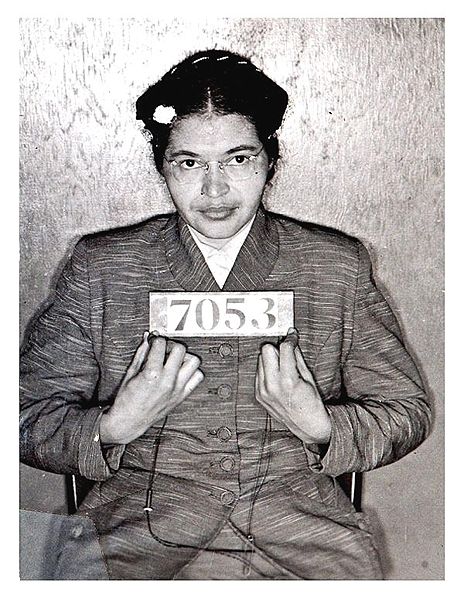|
Rosa Parks, "The Mother of the Modern-Day Civil Rights Movement"
Rosa Parks, whose name was Rosa Louise McCauley, was born on February 4, 1913 in Tuskegee, Alabama to James McCauley and
Leona Edwards. When her parents divorced in 1918, Rosa moved with her mother to a small neighborhood right outside of Montgomery,
Alabama. Rosa was home schooled by her mother up until she was eleven years old. While attending school now, Rosa was able
to see the "separate but equal" effects on life under the Jim Crow Laws in the South. The thing that Rosa was the
most affected by was the lack of public transportation for black students, forcing them to walk to their school while watching
the buses of white children pass them by.
In 1932 Rosa married a Montgomery barber and member of the NAACP, Raymond Parks. With urging from her husband, Parks finished
her high school education and joined the local Montgomery Chapter of the NAACP and was elected volunteer secretary for the
chapters president, Edgar Nixon, in 1943. Also during this time, Parks worked as a cleaner and seamstress for the Durrs, who
a white,liberal family. With their advice and sponsorship Parks began to attend the Highlander Folk School, which was an education
center that focused on workers' rights and equality.
In late November of 1955 Parks and Edgar Nixon began to discuss the next action of the NAACP chapter. Since she was so
disturbed by the lack of public transportation for blacks, Parks brought about the idea for boycott of all public buses. On
December 1 of that same year, Parks boarded a local bus on her way back from work and sat directly behind the ten seats reserved
for white passengers only near the center of the bus. As the bus took its normal route all of the white only seats filled
up completely. At the next stop right outside of the Empire Theater, the bus driver James Blake got up and moved the sign
designating the colored seating back two rows and demanded that the four African-American riders, including Parks, get up
and move to the back of the bus. Parks knew immediately that this would be the perfect opportunity that her and Nixon talked
about and she gained a strong sense of confidence and kept to her seat. Blake asked Parks, "Why don't you stand up?",
to which Parks responded with,"I don't think I should have to stand up." Blake called for the police and Parks was
arrested.
Parks can recall that when she was being arrested she asked the officer,"Why do you push us around?". The officer
replied with, "I don't know, but the law's the law, and you're under arrest."
 |
 |
|
|
|
 |
|
The Montgomery Bus Boycott
On the night of Rosa Park's arrest, Jo Ann Robinson, head of the Women's Political Party, wrote and helped distribute
a flyer throughout Montgomery about the incident. The summary of the flyer was that African-Americans do not deserve such
poor treatment in public and that they make up more than three-fourths of the bus riders and without them public transportation
would not be possible and she called for all African-Americans to boycott the buses on that upcoming Monday, as it was the
day of Park's trial. The next day a large church meeting was held in which many black citizens proposed the idea of a "fixed"
dividing line on all public transportation and that the African-Americans of Montgomery should follow suit of other towns
in the Deep South and stage a mass boycott as proposed by Robinson.
On that Monday of December 5 the amount of blacks riding on the public transportation was very minimal, the proposed idea
of the boycott was successful. The colored people of Montgomery came to the concise decision that the boycott must be continued
as it was big enough to cause the city a huge economic problem. Later that week blacks, and even some white house-wives, began
a carpooling system in which one person volunteered to drive those around them to work or school, opposed to riding the buses.
Black taxi cab drivers began to charge riders the same amount as the buses, which was only ten cents. Others used different
means of travel, such as; riding bikes, walking, hitchhiking, and some even rode in horse-drawn buggies.
News of the boycott and its success spread across all of Alabama. Black churches began to raise money that would be given
to help the citizens pay for gas money and to buy new shoes for those who chose to walk. Many citizens would much rather walk
than ride the city buses as they new the importance of the boycott.
The actions of the black citizens in Montgomery did not go unanswered. When the taxi charges were being lowered by the
black drivers, the cab companies required that all drivers charging less than 45 cents be fired immediately and charged for
fraud. As membership of blacks in the NAACP raised, the membership of white citizens joining the White Citizen's Council more
than doubled. Angered by the success of the boycott members of the council began to resort to violence against the protesters.
Houses, famously Martin Luther King's, and black churches were bombed.
The boycott continued on strong for a long time and was proven to be very successful when on June 4, 1956 the district
federal court ruled that racial segregation on buses was unconstitutional. The boycott continued on until December 20 when
the Supreme Court upheld the ruling of the federal court, banning racial segregation on public transportation. This was one
of the first victories during the Civil Rights Movement.
|
 |
|
|
|
